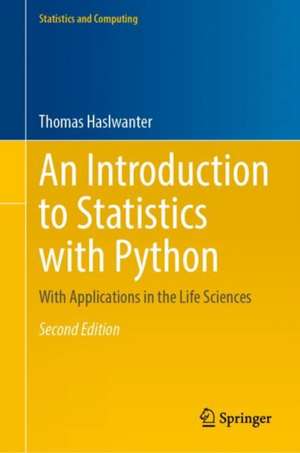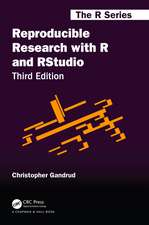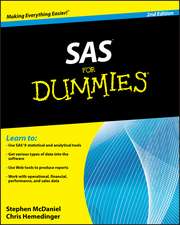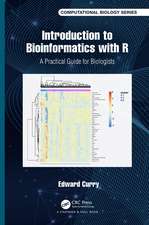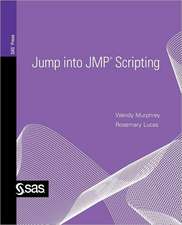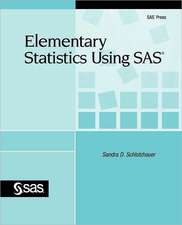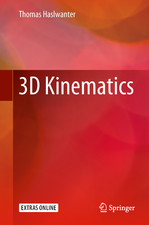An Introduction to Statistics with Python: With Applications in the Life Sciences: Statistics and Computing
Autor Thomas Haslwanteren Limba Engleză Hardback – 16 noi 2022
For this new edition, the introductory chapters on Python, data input and visualization have been reworked and updated. The chapter on experimental design has been expanded, and programs for the determination of confidence intervals commonly used in quality control have been introduced. The book also features a new chapter on finding patterns in data, including time series. A new appendix describes useful programming tools, such as testing tools, code repositories, and GUIs.
The provided working code for Python solutions, together with easy-to-follow examples, will reinforce the reader’s immediate understanding of the topic. Accompanying data sets and Python programs are also available online. With recent advances in the Python ecosystem, Python has become a popular language for scientific computing, offering a powerful environment for statistical data analysis. With examples drawn mainly from the life and medical sciences, this book is intended primarily for masters and PhD students. As it provides the required statistics background, the book can also be used by anyone who wants to perform a statistical data analysis.
| Toate formatele și edițiile | Preț | Express |
|---|---|---|
| Paperback (1) | 388.34 lei 6-8 săpt. | |
| Springer International Publishing – 30 mai 2018 | 388.34 lei 6-8 săpt. | |
| Hardback (1) | 505.20 lei 6-8 săpt. | |
| Springer International Publishing – 16 noi 2022 | 505.20 lei 6-8 săpt. |
Din seria Statistics and Computing
-
 Preț: 228.21 lei
Preț: 228.21 lei -
 Preț: 438.82 lei
Preț: 438.82 lei -
 Preț: 386.81 lei
Preț: 386.81 lei - 20%
 Preț: 753.99 lei
Preț: 753.99 lei - 20%
 Preț: 1059.77 lei
Preț: 1059.77 lei -
 Preț: 426.73 lei
Preț: 426.73 lei - 20%
 Preț: 474.37 lei
Preț: 474.37 lei - 18%
 Preț: 1387.07 lei
Preț: 1387.07 lei -
 Preț: 433.53 lei
Preț: 433.53 lei -
 Preț: 208.58 lei
Preț: 208.58 lei - 20%
 Preț: 1454.73 lei
Preț: 1454.73 lei -
 Preț: 377.18 lei
Preț: 377.18 lei - 23%
 Preț: 652.31 lei
Preț: 652.31 lei - 20%
 Preț: 1174.26 lei
Preț: 1174.26 lei - 18%
 Preț: 959.32 lei
Preț: 959.32 lei - 15%
 Preț: 643.48 lei
Preț: 643.48 lei -
 Preț: 392.75 lei
Preț: 392.75 lei - 15%
 Preț: 640.06 lei
Preț: 640.06 lei -
 Preț: 404.29 lei
Preț: 404.29 lei - 15%
 Preț: 710.42 lei
Preț: 710.42 lei - 15%
 Preț: 695.85 lei
Preț: 695.85 lei - 20%
 Preț: 1276.86 lei
Preț: 1276.86 lei - 18%
 Preț: 1003.38 lei
Preț: 1003.38 lei - 15%
 Preț: 703.85 lei
Preț: 703.85 lei -
 Preț: 384.70 lei
Preț: 384.70 lei - 15%
 Preț: 606.17 lei
Preț: 606.17 lei - 15%
 Preț: 646.94 lei
Preț: 646.94 lei - 15%
 Preț: 589.02 lei
Preț: 589.02 lei - 18%
 Preț: 1117.99 lei
Preț: 1117.99 lei -
 Preț: 503.52 lei
Preț: 503.52 lei - 18%
 Preț: 735.38 lei
Preț: 735.38 lei - 15%
 Preț: 693.90 lei
Preț: 693.90 lei
Preț: 505.20 lei
Preț vechi: 631.49 lei
-20% Nou
Puncte Express: 758
Preț estimativ în valută:
96.68€ • 104.98$ • 81.21£
96.68€ • 104.98$ • 81.21£
Carte tipărită la comandă
Livrare economică 22 aprilie-06 mai
Preluare comenzi: 021 569.72.76
Specificații
ISBN-13: 9783030973704
ISBN-10: 3030973700
Pagini: 336
Ilustrații: XVI, 336 p. 156 illus., 131 illus. in color.
Dimensiuni: 155 x 235 x 27 mm
Greutate: 0.67 kg
Ediția:2nd ed. 2022
Editura: Springer International Publishing
Colecția Springer
Seria Statistics and Computing
Locul publicării:Cham, Switzerland
ISBN-10: 3030973700
Pagini: 336
Ilustrații: XVI, 336 p. 156 illus., 131 illus. in color.
Dimensiuni: 155 x 235 x 27 mm
Greutate: 0.67 kg
Ediția:2nd ed. 2022
Editura: Springer International Publishing
Colecția Springer
Seria Statistics and Computing
Locul publicării:Cham, Switzerland
Cuprins
I Python and Statistics.- 1 Introduction.- 2 Python.- 3 Data Input.- 4 Data Display.- II Distributions and Hypothesis Tests.- 5 Basic Statistical Concepts.- 6 Distributions of One Variable.- 7 Hypothesis Tests.- 8 Tests of Means of Numerical Data.- 9 Tests on Categorical Data.- 10 Analysis of Survival Times.- III Statistical Modelling.- 11 Finding Patterns in Signals.- 12 Linear Regression Models.- 13 Generalized Linear Models.- 14 Bayesian Statistics.- Appendices.- A Useful Programming Tools.- B Solutions.- C Equations for Confidence Intervals.- D Web Ressources.- Glossary.- Bibliography.- Index.
Notă biografică
Thomas Haslwanter is a Professor at the School of Medical Engineering and Applied Social Sciences at the University of Applied Sciences Upper Austria in Linz, and lecturer at the ETH Zurich in Switzerland. He also worked as a researcher at the University of Sydney, Australia and the University of Tübingen, Germany. He has extensive experience in medical research, with a focus on the diagnosis and treatment of vertigo and dizziness and on rehabilitation. After 15 years of extensive use of Matlab, he discovered Python, which he now uses for statistical data analysis, sound and image processing, and for biological simulation applications. He has been teaching in an academic environment for more than 15 years.
Textul de pe ultima copertă
Now in its second edition, this textbook provides an introduction to Python and its use for statistical data analysis. It covers common statistical tests for continuous, discrete and categorical data, as well as linear regression analysis and topics from survival analysis and Bayesian statistics.
For this new edition, the introductory chapters on Python, data input and visualization have been reworked and updated. The chapter on experimental design has been expanded, and programs for the determination of confidence intervals commonly used in quality control have been introduced. The book also features a new chapter on finding patterns in data, including time series. A new appendix describes useful programming tools, such as testing tools, code repositories, and GUIs.
The provided working code for Python solutions, together with easy-to-follow examples, will reinforce the reader’s immediate understanding of the topic. Accompanying data sets and Python programs are also available online. With recent advances in the Python ecosystem, Python has become a popular language for scientific computing, offering a powerful environment for statistical data analysis. With examples drawn mainly from the life and medical sciences, this book is intended primarily for masters and PhD students. As it provides the required statistics background, the book can also be used by anyone who wants to perform a statistical data analysis.
For this new edition, the introductory chapters on Python, data input and visualization have been reworked and updated. The chapter on experimental design has been expanded, and programs for the determination of confidence intervals commonly used in quality control have been introduced. The book also features a new chapter on finding patterns in data, including time series. A new appendix describes useful programming tools, such as testing tools, code repositories, and GUIs.
The provided working code for Python solutions, together with easy-to-follow examples, will reinforce the reader’s immediate understanding of the topic. Accompanying data sets and Python programs are also available online. With recent advances in the Python ecosystem, Python has become a popular language for scientific computing, offering a powerful environment for statistical data analysis. With examples drawn mainly from the life and medical sciences, this book is intended primarily for masters and PhD students. As it provides the required statistics background, the book can also be used by anyone who wants to perform a statistical data analysis.
Caracteristici
Provides an introduction to Python for statistical data analysis Covers common statistical tests and various applications, including their implementation and working solutions in Python Features a new chapter on finding patterns in data, also in time series, and useful programming tools
Recenzii
“This book is a timely addition designed to bridge the gap between statisticians/computer scientists and experimentalists (biologists, physicists, medical doctors) by focussing on solutions to practical problems … . the book also provides hands-on examples and exercises for a better understanding (for which the solutions are included at the end of the book). This approach makes the book appealing to a wide audience ranging from undergraduates in various subjects to established researchers looking for a focused set of answers.” (Irina Ioana Mohorianu, zbMATH 1357.92001, 2017)
